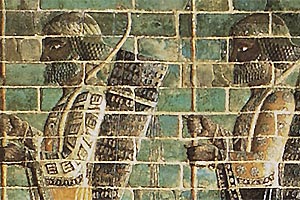Groups of Indo-Europeans originating from Central Asia entered the Iranian Plateau in around 1300 B.C. There were two main tribes: the Medes who settled in the southern part and the Persians in the north, along the shores of the Caspian Sea.
The Medes united to fight the Assyrian Empire of Mesopotamia in the mid 7th Century B.C. and created a kingdom which subdued the Persians. Later King Cyaxares defeated the Assyrians and destroyed their capital Nineveh in 612 B.C. in alliance with the Babylonians from the Mesopotamian city of Babylon.
Cyrus II (later «the Great»), the Persian King of a small state called Anzan, ousted the Mede King Astyages by capturing Ecbatana, the capital, in 550 B.C. Having become the King of Medes and Persians the first ruler of the Achaemenid Dynasty began campaigns to build his great empire.
He defeated Croesus and took Sardis, capital of Lydia, located by the Aegean Sea in Asia Minor in 547 B.C. Here the Hittites had erected their empire in around 2000 B.C., famous for its fabulous wealth.
Cyrus conquered the territories as far as what is now Pakistan between 546 and 540 B.C.
He defeated Nabonidus, the last Babylonian monarch in 539 B.C. and inherited his empire, which included Syria and Palestine.
He later imposed his rule upon Phoenicia and the Greek Ionian cities (in Asia Minor).
He took over all of Western Asia with these conquests, from the Mediterranean and Black Sea to what is currently Pakistan and from the Caspian and Aral Seas to the Arabian Sea. It was the greatest empire ever to have existed.
Cyrus died in a battle with the Massagetae who inhabited the Caucasus (between the Black and Caspian Seas) in 529 B.C.
As far as the Nile
The successor of Cyrus II, his son Cambyses II (529-522 B.C.) headed to Africa and took the Egyptian capital, Memphis in 525 B.C. after defeating the army of Psammetichus II in the battle of Pelusium. He then advanced southwards to Nubia. He also took Cyrene in the east (the current Libya).
These conquests gave the Persians complete control of all of the oldest centres of civilization in the area.
A New Expansion
While Cambyses was in Egypt an impostor passing himself as his brother seized control of the eastern part of the empire.
After the King’s death a council of Persian nobles decided to appoint a prince who had been a general as his successor. Darius I, later known as «King of Kings» (522-486 B.C.), successfully retook the empire. Once the empire was stabilised, he subdued the Indus River region, and doing so reached India’s western zone. From here he ordered an expedition to sail down the river to find a maritime route to Egypt.
In order to ensure control of the Southern Russian commercial routes he then advanced toward the Black Sea, where he was able to make the Scythians retreat towards the north of the sea.
Afterwards he invaded South-eastern Europe, conquering Thrace and Macedonia (where parts of Greece, Turkey and Bulgaria now lie).
On his death the empire had an area of around five million square kilometres.
Decline and Downfall
In the year 499, the Greek cities led by Miletus, located in Ionia in Asia Minor rose up against the Persians. Athens supported these cities by sending part of its fleet.
Darius I controlled the uprising in 494 B.C and decided to attack Athens in reprisal. He landed in Marathon in 490 B.C. but was defeated.
His son and successor Xerxes I (486-465 B.C.) attacked Greece by land and by sea with more than one hundred thousand soldiers and 1,200 ships. He managed to burn Athens, but his fleet was destroyed by Themistocles at the battle of Salamis in 480 B.C. and his army was defeated in Plataea the following year.
The decline of the Achaemenid Persians had begun. Xerxes I became a despot and was finally assassinated. The ensuing monarchs were also despots and contributed to the weakening of the monarchy.
The end came with King Darius III (336-330 B.C.) who was defeated by Alexander the Great. Alexander conquered Asia Minor in 334 B.C., the Syrian littoral in 333 B.C., and later Egypt and Palestine in 332 and in the end suppressed the Persians, taking control of Babylon and Susa in 331 and burning Persepolis in 330. He finally headed towards the Indus Valley, taking over the majority of it between 327 and 325.








 Muere Evita
Muere Evita